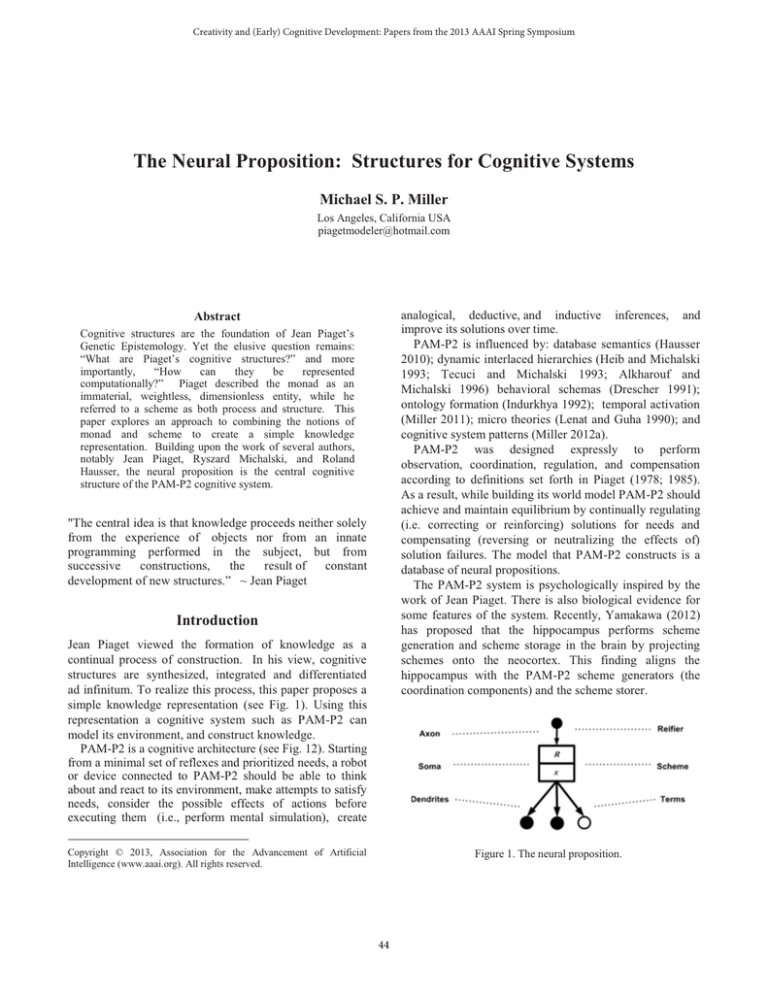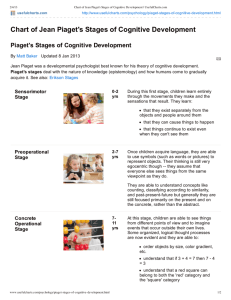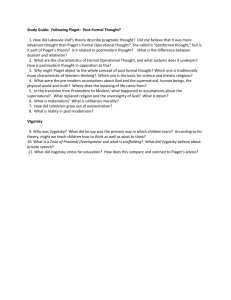Document 13910100
advertisement

Creativity and (Early) Cognitive Development: Papers from the 2013 AAAI Spring Symposium
(% %#$#&'#"'%('(%&#%#"')+&'!&
%
&'%'
! ! !
!
Cognitive structures are the foundation of Jean Piaget’s
+/1+2 %# % 70
! " #
“What are Piaget’s cognitive structures?” and more
2<9<:>
70%/
(
importantly,
“How
can
they
be
represented
9@@=> & /
( 9@@=> ( computationally?” Piaget described the monad as an
/
( 9@@A: %!
7B 9@@9:>
$
$
76(9@@2:>
!
% &
7/
2<99:>79@@<:>
'
% ($
!7/
2<92:
)
$(!
+/1+2 $ '
%
* + -. /
( -
%! 0 !
+ 79@DE> 9@EF:
+/1+2!
$
%
$
+/1+2
!"
%%
3&
($
7 : ' %4 7! . :
%4 % & +/1+2 ! %
development of new structures.” ~ Jean Piaget
& +/1+2 % $(*+&
%
! -
($ 72<92:
"'%#('#" * + !$ ($
% % 4
6 !$ !
' & . $ +/1+2 7
&
.
:
($
7 8 9: ! +/1+2 !($
+/1+2!7892:
'.%
! +/1+2 % %
(
%!(
%
%
' 7 : ; 2<9= ! 6
7$$$:
!
89&
44
'!$%
%$%
$%
'8
the proposition’s ac! 1% 6 $
# 7: $
7:
% %%
!%
!
!7
:
# &
Often a monad’s activation is required to achieve or
T %
+/1+2
%I'$%
I 6 %$
! ' &
' % %
' % !
%!
%
$
'
#"&
%. $
*+!%
8 $ !6$
$'
to be a “newly synthesized” concept7B9@@9: 8 ! G
%
! 7$ % I I G: ( 7 $ : 7 :
+&
!!
$ 78 =%: T %
!
! I $
8
!!
.
$
%
(
$$78=:
! * + ! ! ! as negative characteristics: “…this means that there will be
%$
%
be made more or less explicit” (Piaget 1985@:
92=
YFYZF9
82!%!7%
or “On”), neutral (i.e., “Void”), or inactive (impeded or “Off”).
&$92=
&%) &##%"'#"&"
'&
'
represent what Piaget calls an “observable”. “An
%!%
% %
%
immediate experience of the facts themselves” 7+
9@EF:. “An observable is that which experience makes it
%
% !
events themselves.”(Piaget 1978)
T $
$ $ ! %!%
& $
6 %!%
“”
6 +/1+2 % %!%
“” 8=/
!&
'#"&
8 '
6 +/1+2 1
$ 8
'
45
%!&
& $ ( '
6
.%+/1P2’s inferential
& $ examples of “internal relations” +/1+2#
\6I\7': I+&6I\7':
-67': B688-\&7':
/7': 6/6-7': 7': &+7':
]+&7'.: +-B6&7$'.:
Each scheme has fillers called “terms” which function in
% !
7 4
4"
:
'
% 7 : ! 7 : % +/1+2!
!&
* + $ % ! 6 !
$
!0%
'%
$ # &
proposes that the “foreign elements” that / %
8F8
%&#"!&"+"!&
6 ! $ -
6 +/1+2
$
$ %%
T
%
is called a “Moneme”. When a dyad reifies a scheme, the
%on is called a “Dyneme”.
8Y%
8A&
/B
.
&
% % 7 8 Y: 1
7$
:
7$":
#"!&)&
%!&
%4 & % “slots” and the values of those attributes are called fillers.
. ' 8 46
" $
" % ! % I !"%
. ' ( T .'$
$
78D:
d1: “Albert Einstein”. d3: “Physicist”. d5: “Psychologist”. d7: “Academic”. @#72YF: 99#&+7AD:
d2: “Jean Piaget”.
d4: “Biologist”.
d6: “Scientist”.
E#79=:
9<#&+7=YFA:
Y#792=:
Y#I+&6I\7F:
F#792=:
Y#I+&6I\7FA:
m5: A(m1, m2, m3) as “A1”.
m6: A(m1, m2, {m3, m7}) as “A2”. 8 @ 7: Y %1 9 2 % 7%: I+&6I\
%$7:
$ 9 $ 2
7+9@EF:
')'#"
8D
.'
) ! !
"'%'#""%"''#"
/ 7 8 E: 7 8 @: T $
!&
7 : % $
m4: A(m1, m2, m3) as “A1”. m9: A(m5, m6, {m7, m8}) as “A2”.
')'#"
#*
$ % $
! $ $ ! $ & $ % 8 '
\6I\ $ & &+ $
7%
: $ $
&
&+
!
$
%!')'#""%+$&
A term has an activation of “On”, “Off”, or “Void” much
$!&!
% scheme’s relation
& ' % # + \I&
\B I- \\B \I- 7 8 99: $ ! propagated to the scheme’s reifier. When all afferent terms
!
m10: A(m1, m2, m7) as “A3”. m11: A(m1, m3, {m7, m8}) as “A4”.
8E/Y@%
9<99
47
! I !
7:!
#!"'&
8 ! — "
=9FFA
6+/1+2 8 '
2<9FF<<F<F<F<<<< 9 *
2<9F 92#=<#=< 8'
=
'
9<<<
')'#""#*
& +/1+2 parameter called the “Activation Window” which
%!
%%!$$
!&
–
79:
! % % !
&
%!
899&!
’
892+/1+2
48
#" (&#"&"
('(%#%
!$#% ""#
$( +/1P2 system’s external
$
+ $
7 :
6
% $ $
.
& +/1+2 !
$
!!
'
$
I $ ! ! &
$ $ $ !
72:
I $ % ! $ $ $ %TI
$#
7=:
G $ ! % ! &
$
!%%
TG
$#
!
"
:7Y:
"
& ! %
$ $ %
$!
"#* !"'&
& $
( ( $ ! !
! %( +/1+2
/ %
& B ( B 8( B -
0 B.Stuart Allen’s animations have enhanced
the understanding of the cognitive system’s objectives.
( B ! /
/ $ 0
/+/
/(+/1
+2
%"&
( \ /
( - 9@@A /
1 &(
! B
6
0 $% & '(
%)*%
7F:
then ‘Void’
then ‘On’
then ‘Off’
Else ‘Void’
*->)/B>>)
B>%>
B
2<<Y $)%+G
666\Y#9<=A–9<A<
) * 2<<@ +
6
+6# /!, -&%
'
(
) * 2<<< /
.
# %$ %
. 6 $% %% &(
(
.
((1G
&(&&#"
0 2<<Y & ! # /
!B!
-%-%
2<<Y &
- &-<Y1=Y 6
%&!&'&]
& $ /
+ 79@Y=:
. !
T/
+
.
!%
! ! 7 \6I\
I+&6I\ : ! '
$
& ($
6
—%4 %T\
($
!
Piaget’s notions of monad and scheme or his
'"
* 9@EA ) & /
%2E79:
B * / 2<<= B% !
#%
%
&
- G
9F \ Y
B%#2=912Y=
B 2<<A \1+ & !
B!
\1+ . T T
( 8 2<<A &
$(
G
/). $)%# 9@912A= # 01
G
B 9@@9 ' 0 '&
(
%/6&+
49
8%B
9@@= 1(%$-2
%/#/6&+
/ &> I &> T 2<<9 %!%
I%!%
#&-
-
08-
82<99()%#!6
63%%%+!
2A<2#2<@1
2=A
/
&9@@<4)%?('
&(
' -
(%
#9E1YF
/
*+9@@A4% %
%
*)
1G
8> \> B 2<92 ! I &
# ' +
(
( '
4
I>/>\>-2<9< “On1
1Based Planning” in &(
%<(
G
2A6\9
0*9@E@&51$%!%$%
').+6#9Y12@
I$ 9@@< %) (
+% +
0 - 2<9< &(
' ( *%(%
&(
6 $(
4
-
G
)
0
%
+ * ( / 9@FA % % &6
!+79@A@1F:
0% /- /
( - 9@@= /
6 /
&( ! # B 6
0 6 $% - .'(
%)*%, Harper’s Ferry, WV.
+ * ( / 9@FD &
(
+
) &))(
+*>>08/9@A2$)66
&\
0
*0> 0
( *> \% -> &+-
9@E@(
$ *%4)#
/6&+
+*-
9@DE4
(%
@(
&%
-
(
(G(+
0
I 2<99 & %
% 6 $% -1
7899-)('&(YF1YD(
+ *> )$ &> & * 9@EF @(
&%
-
(
( &
$ (
4
6( ) 9@@2 '
&%
$
+ *> /> T 8 2<<@ +I1+# 2 7 ($: T I
2<<E#9Y
0*2<<@/1-6!
&+1)+
2&51+%
+4
:
& &5
1+%6&&1+788;
T#29<122Y
+(/>/BI&2<<F
+
6
+( /> I & 2<<F & # 8 / B 6
+ (
,
6 >
-)(6
-+
*> \$
> -%
+ 9@ED # 6
<( %G
==69%#91AY
T-
/09@E2-
% (
*%(%$%$
%
.->0.>.2<99
6 $% -17899-)('&(
B ) - G 9@@< 1(% *% 3%
1-)
+
&)$=
/ 2<<A ! %
$ %
$( &( &%
9F
/
T+T09@Y=
! ! 1(
'
1)G
F#99F19==
& /
( - 9@@= 6
& ' *%6 '(
%) G
6G
/
/ + 2<99 + /
6
$% -1 7899 -)( &(
' &%
4
#=21=@
($ 0 2<92 0
$
%
A %6 *
( &(
-#=A21=D9
/
/ + 2<92 + ! 6
$% -,
& &,6
%
- -)
766:+
6
/
/+2<92%&\
+
0(
/
/ + 2<92 & -
\
+
0(
/
/+2<92!/0(
/>I-2<<@
1 6 ;
( & &1+%&&1+788;
/+0\-9@EA-$
1)&/6$%
5:>#9=19D
50




